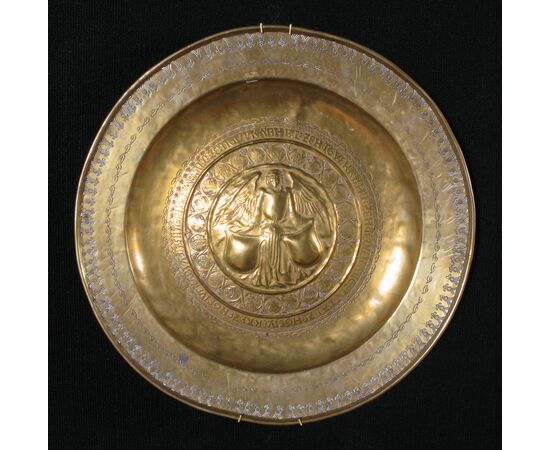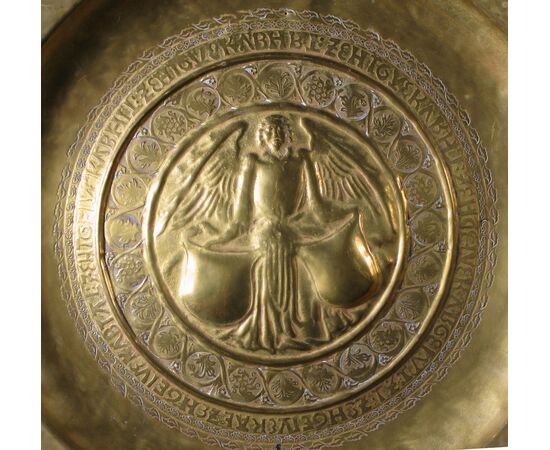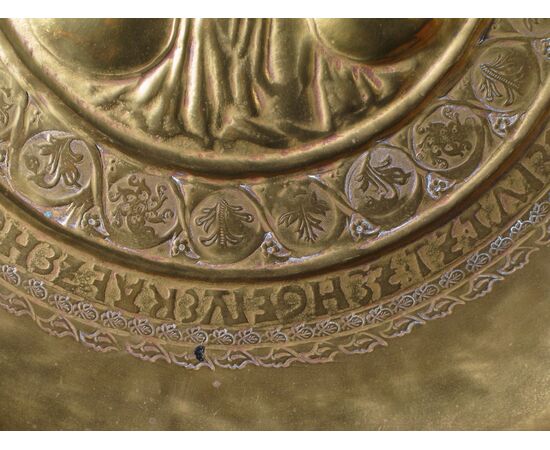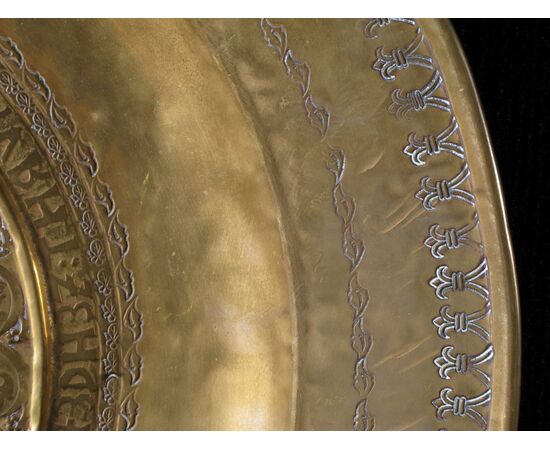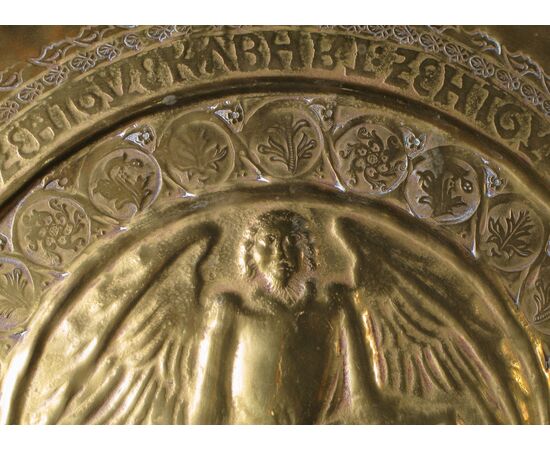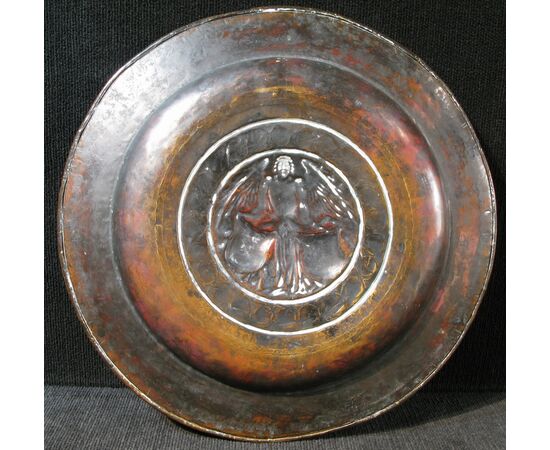Piatto da pompa “Elemosiniere” - Sud Germany (Norimberga), XVI° secolo
Ottone battuto, sbalzato e lavorato a punzone
Sud Germany (Norimberga), XVI° secolo
Clipeo centrale figurato con Angelo reggente due scudi; circondato da doppia fascia ornata a lettere dell’alfabeto e figurazioni fogliacee vegetali inserite in piccoli cerchi susseguenti.
All’esterno di esse , una doppia corona a motivi fitomorfi chiude la rara e ricca ornamentazione della parte centrale del piatto.
Largo bordo decorato a punzone con doppia corona; la prima vegetale e la seconda presentante stilizzati motivi architettonici.
Il piatto, in ottimo stato di conservazione, di grande rarità in riferimento all’ornamentazione, e di notevole misura, si colloca nella produzione del sud Germany (Norimberga) del XVI° secolo.
Questi manufatti venivano realizzati tramite battitura a freddo su dei negativi precedentemente creati, e ornati a punzone
La loro funzione poteva essere a carattere liturgico…o profano.
Il valore decorativo di questi splendidi manufatti del colore dell’oro faceva si che spesso ornassero e arricchissero l’interno di abitazioni patrizie.
Quante volte ci è capitato di vederli ritratti in dipinti italiani o fiamminghi del periodo rinascimentale raffiguranti gli interni di sontuose abitazioni.
O inseriti, sempre con valore ornamentale, ad addobbare gli ambienti, durante feste e ricchi banchetti.
L'opera, come ogni altro nostro oggetto, viene venduta corredata da attestati di autenticità e lecita provenienza.
Ci occupiamo ed organizziamo personalmente l'imballaggio e la spedizione delle opere d'arte con assicurazione in tutto il mondo
Nel caso l’opera venisse acquistata da clienti non italiani la stessa necessiterà dell’attestato di libera circolazione.
Lo stesso è ottenibile in 10/20 giorni lavorativi.
La galleria si occuperà degli aspetti burocratici ed economici della cosa.
Tutti i costi dell’operazione sono quindi inclusi nel prezzo.
Bibliografia di riferimento
-Tamàs Egyeki – Szabo, Beckenschlagerschusseln (15.-16. Jahrhundert), Mester Niomda, Budapest 2008
-Oleg Zastrow , La collezione dei bacili di ottone del XV° e XVI° secolo nelle civiche raccolte d’arte applicata del Castello sforzesco
-Hermann P. Lockner, Messing - 15-17 Jahrhundert, Klinkhardt & Biermann, Monaco 1982
English
“Elemosiniere”
Wrought, embossed and punched brass
South Germany (Nuremberg), 16th century
Central clypeus with an Angel holding two shields; surrounded by a double band decorated with letters of the alphabet and leafy plant figures inserted in small successive circles.
Outside of these, a double crown with phytomorphic motifs closes the rare and rich ornamentation of the central part of the plate.
Wide edge decorated with a punch with a double crown; the first vegetal and the second with stylised architectural motifs.
The plate, in an excellent state of conservation, of great rarity in reference to the ornamentation, and of considerable size, is placed in the production of southern Germany (Nuremberg) of the 16th century.
These artefacts were made by cold hammering on previously created negatives, and decorated with a punch
Their function could be liturgical...or profane.
The decorative value of these splendid gold-colored artifacts meant that they often adorned and enriched the interiors of patrician homes.
How many times have we seen them portrayed in Italian or Flemish paintings from the Renaissance period depicting the interiors of sumptuous homes.
Or inserted, always with ornamental value, to decorate the rooms, during parties and rich banquets.
The work, like all our other objects, is sold accompanied by certificates of authenticity and lawful provenance.
We personally take care of and organize the packaging and shipping of works of art with insurance throughout the world
If the work is purchased by non-Italian customers, the same will require the certificate of free circulation.
The same can be obtained in 10/20 working days.
The gallery will take care of the bureaucratic and economic aspects of the matter.
All the costs of the operation are therefore included in the price.
Reference bibliography
-Tamàs Egyeki – Szabo, Beckenschlagerschusseln (15.-16. Jahrhundert), Mester Niomda, Budapest 2008
-Oleg Zastrow , The collection of brass basins from the 15th and 16th centuries in the civic collections of applied art of the Sforza Castle
-Hermann P. Lockner, Messing - 15-17 Jahrhundert, Klinkhardt & Biermann, Munich 1982
Français
Plat d'offrande
Laiton forgé, gaufré et poinçonné
Allemagne du Sud (Nuremberg), XVIe siècle
Clipeus central représenté avec un Ange tenant deux boucliers ; entouré d'un double bandeau orné de lettres de l'alphabet et de figures végétales de feuilles insérées dans des petits cercles successifs.
A l'extérieur d'eux, une double couronne à motifs phytomorphes ferme l'ornementation rare et riche de la partie centrale de l'assiette.
Large bord orné d'un poinçon à double couronne ; le premier végétal et le second présentant des motifs architecturaux stylisés.
L'assiette, en excellent état, d'une grande rareté en ce qui concerne l'ornementation, et de dimensions considérables, appartient à la production de l'Allemagne du Sud (Nuremberg) du XVIe siècle.
Ces objets ont été réalisés par frappe à froid sur des négatifs préalablement créés et décorés à l'aide de poinçons.
Leur fonction pouvait être liturgique… ou profane.
La valeur décorative de ces splendides objets dorés faisait qu’ils ornaient et enrichissaient souvent l’intérieur des demeures patriciennes.
Combien de fois les avons-nous vus représentés dans les peintures italiennes ou flamandes de la Renaissance représentant des intérieurs de demeures somptueuses.
Ou inséré, toujours avec une valeur ornementale, pour décorer les pièces lors de fêtes et de riches banquets.
L'œuvre, comme tous nos autres objets, est vendue accompagnée de certificats d'authenticité et d'origine licite.
Nous prenons en charge et organisons personnellement l'emballage et l'expédition des œuvres d'art avec assurance dans le monde entier.
Si l'œuvre est achetée par des clients non italiens, elle nécessitera un certificat de libre circulation.
La même chose peut être obtenue en 10/20 jours ouvrables.
La galerie abordera les aspects bureaucratiques et économiques de la question.
Tous les frais de l'opération sont donc inclus dans le prix.
Bibliographie de référence
-Tamàs Egyeki – Szabo, Beckenschlagerschusseln (15.-16. Jahrhundert), Mester Niomda, Budapest 2008
-Oleg Zastrow, La collection de bassins en laiton des XVe et XVIe siècles dans les collections civiques d'art appliqué du château des Sforza
-Hermann P. Lockner, Messing - 15-17 Jahrhundert, Klinkhardt & Biermann, Munich 1982-

